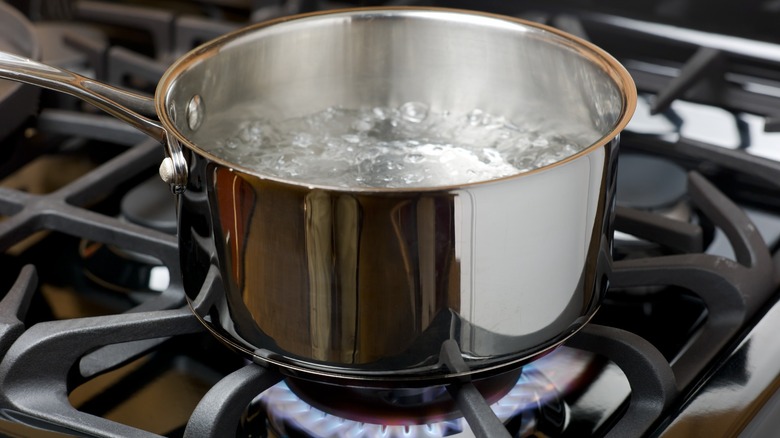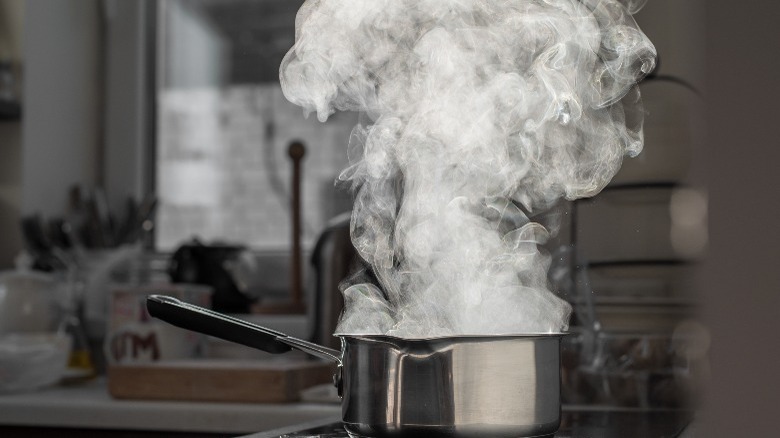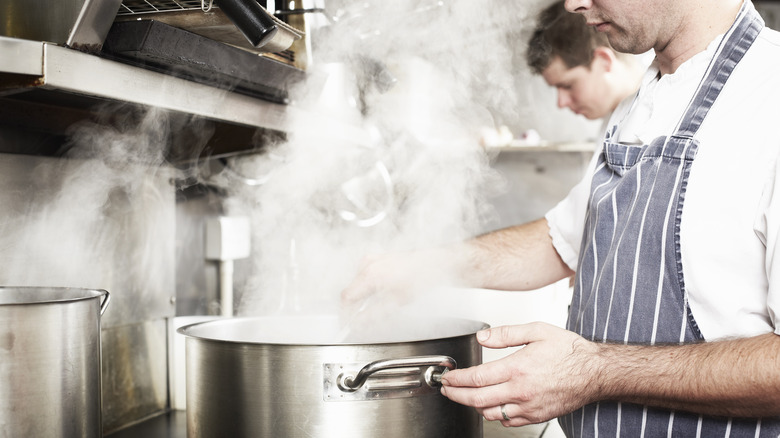Why Water Boils Faster In High Altitude
Water boils at around 212 degrees Fareneheit or 100 degrees Celsius, but those temperatures technically only apply at sea level. The boiling points actually vary quite a bit based on the surrounding atmospheric pressure, which means that altitude plays a role in the kitchen when making anything that requires a rolling pot of water. That's due to the remarkable nature of what happens to water on a molecular level when there's less air pressing down on liquid.
It doesn't take a degree in chemistry or physics to know that molecules are the building blocks of everything around us, and ever-present energy is constantly making these particles bounce around. More energy, as in higher heat, makes molecules move even faster. When you boil water, you're literally speeding up liquid H20 molecules so much that you're breaking their bonds and letting them travel into the air in a gas state known as vapor or steam. The constantly mobile nature of molecules also means that the more space they have to move around in, the more likely they are to escape from each other. This is where atmospheric pressure, literally the weight of the air depending on the altitude, comes into play.
How molecules move
Although air feels like, you know, air, oxygen molecules exert pressure on water molecules on an atomic level, helping to keep them confined into a liquid or solid (a.k.a. ice) state. However, air gets less dense at higher altitudes, which is why mountain climbers need oxygen tanks to help breathe in all those freer-flowing oxygen particles. That also means that there's more room for water molecules to travel freely in. Think of it like being squished against a wall at a crowded party, then suddenly being able to move around the room when people start leaving.
It's much easier for liquid H20 to turn into steam when there's less air keeping the molecules from moving freely, so it takes less heat energy to break their bonds. For instance, at 2,000 feet above sea level, the boiling point of water slightly decreases to 208 degrees Farenheit. 3,000 feet, when water boils at 206 degrees Farenheit, is when the temperature will start to more actively and noticeably affect cooking times. Conversely, the boiling point lowers and cooking time increases in altitudes below sea level, meaning that water won't boil until it's past 212 degrees Farenheit in places like Death Valley. Technically, water can even boil without a raise in temperature if the pressure is low enough, though this requires scientific equipment like a special vacuum and a reinforced beaker like those found in chemistry labs.
Cooking in the mountains
All this is to say that if you're working in a kitchen in Denver, Mexico City, or somewhere else significantly above sea level, and you're following a recipe that requires precise boiling points and cooking times, you must make adjustments. A lower boiling point doesn't mean that food cooks faster at higher altitudes. In fact, food actually needs more time to fully cook through since boiling reactions occur at lower temperatures, a vital detail to remember if you ever want to avoid battling food sickness and altitude sickness at the same time. You may find yourself pouring additional water into a pot so that pasta, potatoes, eggs, or anything else heating up inside doesn't boil dry.
Since all cooking is chemistry, the lower pressure in higher elevations impacts recipes in other ways, as well. All gases rise and move around faster, which means leavened loaves of bread and other baked goods will rise faster. Air also becomes dryer due to less oxygen, so liquid tends to evaporate quicker while other, more solid ingredients, such as sugar, become more concentrated. A pressure cooker that can stabilize pressure at more precise temperatures can help overcome these difficulties, but make sure to keep science in mind when cooking at higher altitudes.



